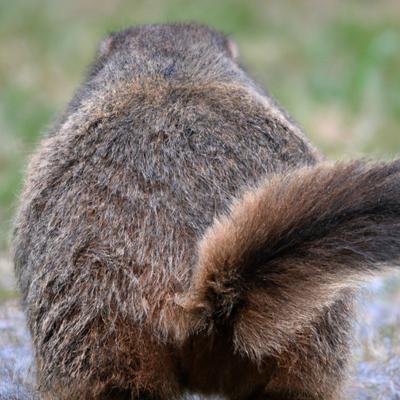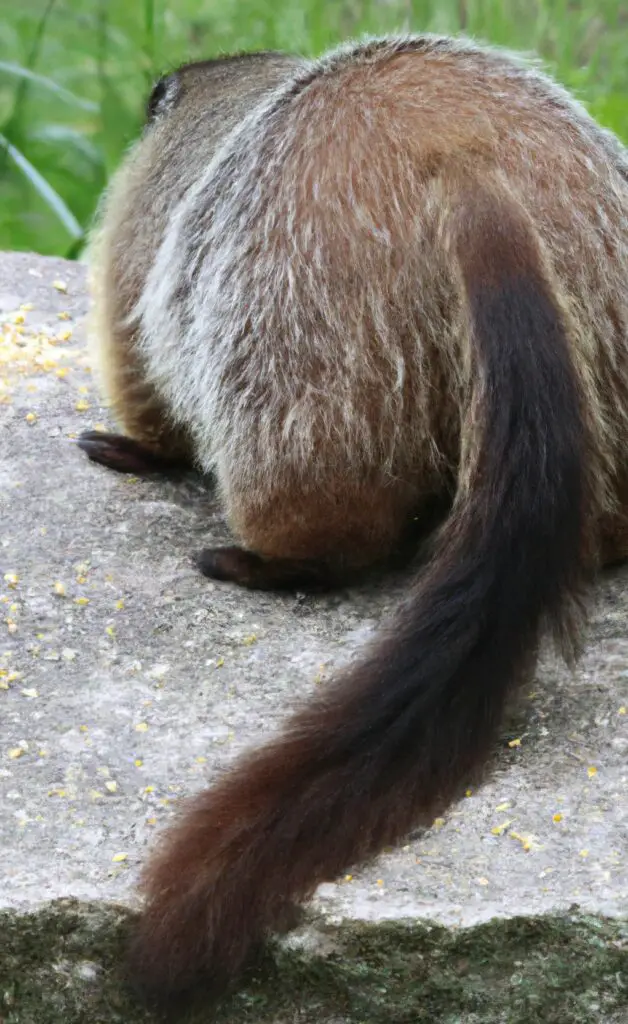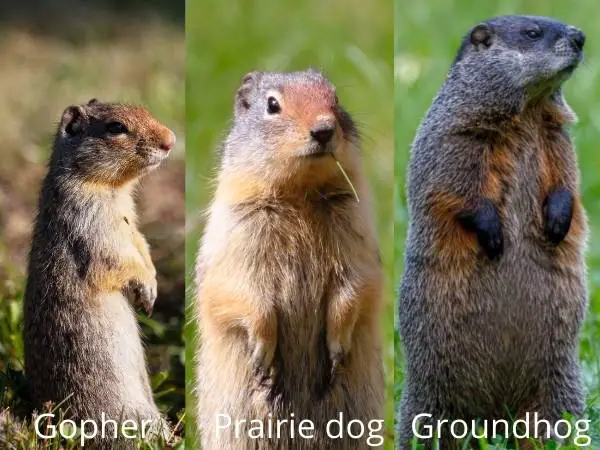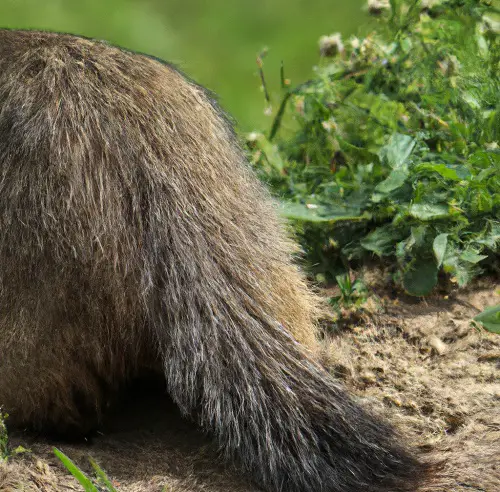Those who have ever wondered what the tails of groundhogs look like need to look no further. This article will provide you with all the information you need to know about groundhog tails.
Groundhogs are small rodents with compact bodies and short, powerful legs. They are also adapted to digging. They have chisel-like teeth and long, broad claws for digging. Groundhogs are also known for their bushy tails, which are covered in thick, bushy fur.
Groundhogs live in North America, in wooded areas near fields and grasslands. They are herbivores, eating a variety of plant material, and supplementing their diet with insects.
Contents
Do groundhogs even have tails?
Yes! Most adult groundhogs have a tail of 5 to 7 inches when fully grown.
However, sometimes this tail is only partially visible as it can be shorter and seems to blend in with the fur on the back of the groundhog. This is especially the case when the groundhog has longer, more dense, fur during the winter months.

It may also, in rare cases, have lost its tail entirely or partly. This occurs when the groundhog is in a fight, or the tail is damaged by diseases.
Male groundhogs usually wag their tails when they enter their burrows. They use this gesture as a way to attract female groundhogs. They also use it as a signal to other groundhogs to avoid danger.
This tail helps the groundhog to sit upright and provides stability. It also helps groundhogs to attract a mate. Many animals wag their tails to greet others or to let other animals know they are happy.
What does a groundhogs tail look like?
Unlike most other rodents, the groundhog’s tail is only a fraction of the length of its body and it has long hairs all over!

It has the same color as its fur and is often hidden on the side of the groundhogs body. But I will let the pictures talk – see for yourself!

Do Groundhogs Have Long Tails?
Not relative to their body size and related species, but some individuals have longer tails than others.
A groundhogs tail is around 6 inches long and an average groundhog is 25 inches long in total. So the tail makes up 25% of its body length with is not considered short, but also not the longest.

This is relatively short compared to other rodents, but gophers, for example, have even shorter tails!
Gophers have an even shorter tail only contributing around 20% to their body length, whereas most mice and rats have much longer tails.
Compare this to a rat, where the tail is the same length as the rest of the body! So a rats tail is 50% of its full body length or twice the relative length of a groundhogs tail.
What shape is a groundhogs tail?
Unlike the short, hairless tail of a beaver, the tail of a groundhog is more round and much more furry!
Groundhogs are among the larger rodents and are found in the Eastern and Western portions of the U.S. and they have some of the largest tails of rodents, but not compared to their body size – here the Long-tailed hopping mouse wins the prize…
Groundhogs are commonly confused with prairie dogs and gophers, which both have shorter tails lighter in color and the groundhogs tail is somewhat more bushy and dark.

Otherwise, they resemble gophers quite a lot and they enjoy the same diet.
What color is a groundhogs tail?
During the mating season, a male groundhog wags his tail. It helps to attract a mate. Some other animals wag their tails to say hello or express happiness. Typically, male groundhogs are larger than females.
The color of groundhog fur varies according to the general fur color of the groundhog. The outer coat of the groundhog is rough and coarse, which is also the case for the tail.

The tail fur helps to keep the groundhogs tail dry and warm. The fur on the underside of the groundhog is more dense and soft, but not on the underside of the tail!
Groundhogs are very active during the day. They also climb trees to escape predators. They are known to eat other animals, but they are mainly herbivores.
The color of their tail allows them to blend in well with the ground and tree trunks if needed to escape a potential threat.
How does a groundhog tail compare to a beaver’s tail?
The main differences are that a groundhog’s tail is much shorter than a beaver’s tail and that a beaver uses its tail mainly for swimming!
A groundhog’s tail is usually about 6 inches long and is covered with fur. The beaver’s tail is much larger, averaging 18 inches in length and without fur.

Both animals use their tails for balance while swimming and climbing.
The main difference between the two tails is the shape and the amount of hairs. The groundhog’s tail is narrow and tapered, while the beaver’s tail is flat and wide.
The beaver can use its tail as a paddle when swimming, whereas the groundhog cannot, because it rarely swims.
But even groundhogs do swim once in a while, which you can read more about here!
What animals look like groundhogs but have different tails?
So you might have heard that groundhogs do not have tails or seen an animal that looks like a groundhog, but where the tail was missing.
These misconceptions could be due to the fact that there are some animals that look a lot like groundhogs but do not have a tail (or at least a less visible one…)!

One such animal is the nutria, a type of water rodent, which has more like a rat tail, so it is much less visible than the bushy tail of a groundhog.
The second animal that may be confused with a tailless groundhog is the capybara. The capybara truly does not have a tail! And I will go into details with the capybara below.
The Nutria
During the mid-1800s, fur traders brought the nutria to North America. The nutria is now considered an invasive species in some places.

Nutrias are semi-aquatic mammals. They live in burrows near streams, lakes and ponds. They are capable of swimming very well. They can also live in water for long periods.
They have long coarse hairs that vary in color. Their outer hair is brown or yellowish brown, and they have a thick, shaggy undercoat. They also have a white patch on their muzzle. They have four long incisors, and webbed hind feet.
Nutria can live in groups of two to thirteen individuals. They often include related adult females. In the wild, they can survive for two to three years. In captivity, they can live for up to twelve years.

These animals can also live in freshwater and saltwater habitats. They live in marshes, and are considered an invasive species some places in Asia and Europe.
They are known to eat many agricultural crops and are a significant threat to native species.
As you can see on the picture, they do have a tail, but it is a thin one without hairs! Almost like a rat, but not as thick compared to the body size.
It does not need its tail to be furry as this would cause to much resistance when swimming and it gets wet and cold anyways!
The Capybara and Its Missing Tail!
Despite the name meaning “master of the grass”, the capybara is more of a water pig.
It is a large rodent that spends a fair amount of time in water, but also on land. While a little unwieldy, it’s actually the largest rodent in the world – that is, the largest relative of the groundhog!
But it has no tail…

The capybara has a number of interesting and funky features apart from having no tail!
The capybara has two toes on each front foot. They are also surprisingly agile. As for size, the average capybara weighs around 150 pounds.
They can be found in Central and South America. They aren’t considered endangered, but they’re under threat from habitat loss and illegal poaching.
They are also good swimmers. In fact, they’re often seen wallowing around in shallow water, much to the delight of humans.
They also have a few notable qualms, including a poor sense of smell and a tendency to bite people’s ankles.
They’re also known to get a little nutty when it comes to food. They also spit out their food in record time, an interesting fact given that they eat a lot of reeds.
The best way to get a handle on the capybara is to visit its natural habitat. You’ll find these little creatures living in grassy, open areas bordering rivers.
Conclusion
If you see something like a groundhog swimming, look at the tail to tell if it is a groundhog, a nutria or a beaver!
If it is fluffy, it’s a groundhog, if its round and smooth, its a nutria, if it is flat and smooth, its a beaver!




